Chapter 3: Internal resources, capabilities and competences
Chapter learning objectives
Upon completion of this chapter you will be able to:
- develop suitable CSFs for products and services
- define and describe strategic capability, threshold resources, threshold competences, unique resources and core competences
- use the resource audit to determine organisational strengths and weakness
- apply the life cycle model and discuss how product costs can change over a product's life cycle
- perform effective quantitative analysis
- apply the SWOT model in a scenario.
1 Introduction
This chapter looks at the internal position of an organisation.This will help determine how well the organisation can cope with theexternal and competitive environment which was analysed in the previouschapter. This internal analysis focuses on identifying the strengths andweaknesses that are particular to an organisation.
The chapter ends by looking at SWOT analysis, which brings togetherinternal (strengths and weakness) and external (opportunities andthreats) factors to allow organisations to assess their strategicposition.
2 Critical success factors
An important strength for any organisation will be the achievementof critical success factors. This should allow the organisation to copebetter than rivals with any changes in its competitive environment.
What are critical success factors?
Critical success factors (CSFs) are performance requirements thatare fundamental to an organisation's success. In this context CSFsshould thus be viewed as those product features that are particularlyvalued by customers. This is where the organisation must outperformcompetition.
Examples of CSFs for major industries include:
- in the automobile industry – styling, an efficient dealer network, organisation, performance
- in the food processing industry – new product development, good distribution channels, health aspects (e.g. low fat)
- in the life insurance industry – reputation, innovative new policies
- in the supermarket industry – the right product mix available in each store, having it actually available on the shelves, pricing it correctly.
Measured targets for CSFs are called key performance indicators (KPIs).

 Test your understanding 1
Test your understanding 1
What might a parcel delivery service such as DHL identify as its two main critical success factors?


 The performance pyramid
The performance pyramid
Developing suitable critical success factors
In developing CSFs from customer needs, the following issues should be borne in mind:
- Customers' buying decisions are often complex and may involve a wide range of motivating factors. CSFs need to focus on the most important factors that ultimately determine the buying decision. Using IT systems to understand customer needs is particularly important in consumer markets.
- Many factors are taken for granted by customers (e.g. fitness for purpose). These give rise to 'threshold' features – i.e. all products must have these simply to enter the market.
- CSFs will vary from segment to segment. The organisation will need to assess its strategic capabilities to identify which segments it should target.
- Customers' understanding of value can vary over time, so the organisation needs to be open to changing the monitored CSFs.
Example: buying a new car
- Motivating factors include brand, image, price, service interval, running costs, safety, warranty, performance, reliability, dealer network, availability and cost of extras (e.g. air-conditioning, leather seats), fuel economy, economic footprint, depreciation, etc.
- Reliability is likely to be a threshold product feature.
- Corporate purchasers may focus more on price (including discounts), running costs and depreciation.
- Families may be more concerned about safety whereas single young males, image and performance.
CSFs then need to be translated into a range of KPIs.


 Examples of Critical Success Factors
Examples of Critical Success Factors
The syllabus focuses on CSFs linked to customer needs. In practiceCSFs can be much more general than this. An organisation will developits CSFs when it determines its mission and objectives.
- The mission statement represents the aspirations of the organisation.
- Long-term objectives may be expressed in terms of increasing shareholder returns or shareholder value added for a profit-seeking company or to relieve poverty in developing nations or save rare animal species for a charity, i.e. a not-for-profit organisation.
- CSFs relate to how objectives can be attained and should be identified early in the strategic planning process.
- Functions and processes refer to the KPIs that help to measure the achievement of CSFs.
- Activities refer to the day-to-day functions that drive the organisation and the need to do these with excellence.
For a profit-seeking organisation, CSFs should relate to the keyfactors for business success, which are typically the following:
- profitability – traditionally the primary objective is growth in earnings per share
- market share
- growth
- innovation
- productivity – targets will be associated with manpower, plant, yields and costs
- customer satisfaction
- the quality of the firm's products.
Not-for-profit organisations should also provide evidence ofstakeholder value and show how its activities are, or will be, able tosupport its aims. The CSFs for a charity should relate to the progressthe organisation's work is making towards its charitable objectives. Forexample, for a charity aiming to save rare animal species a CSF mightbe to reduce demand for clothing made from rare animal fur.
KPIs used to assess performance in relation to the CSFs identified may be:
- quantitative – direct measures of sales, costs, ROCE and profit
- qualitative – market share, customer base; % sales growth, labour turnover, % of deliveries on time, customer returns as a % of total sales, complaints per £ of sales, reduced percentage of local population contracting HIV/AIDS or the number of countries prohibiting rare animal fur imports
- relative or absolute – relative measures are frequently more useful than measures in absolute terms, e.g. complaints per customer may be more useful than simply the number of complaints; gross profit per unit (or as a % of sales) may be more useful than total gross profit
- value for money (VFM) measures – the pursuit of economy, effectiveness and efficiency are mainly used by the public sector and other non-profit-seeking organisations.
Measures for service efforts and accomplishment fall into four categories:
- input measures – the effort expended on a programme – 'economy' is a measure of inputs to achieve a certain service
- output measures – the level of services provided – 'effectiveness' is a measure of outputs, i.e. services and facilities
- outcome measures – the effect a service has on the programme's stated objectives
- efficiency measures – a comparison of the level of inputs with outputs or outcomes – it is the optimum of economy and effectiveness, i.e. the measure of outputs over inputs.
Charities are very accustomed to measuring in this way:
- they report on the financial resources dedicated to specific programme in their financial statements and the non-financial information about the effort they expend, such as the hours spent meeting a programme goal
- output measures are often stated in non-financial terms, e.g. a homeless shelter may report the number of people housed
- outcome measures gauge how well a programme accomplished its goal, e.g. a programme designed to teach reading to adults may use the literacy rate for the area served as an outcome measure
- a way to measure the efficiency of this programme could be to compute a cost (input) for each adult who reaches a certain reading level (output).


 Illustration 1 – Critical success factors
Illustration 1 – Critical success factors
The following is an example of CSFs developed for a shipping terminal.




 Test your understanding 2
Test your understanding 2
Using the CSFs previously identified for a parcel delivery companysuch as DHL, explain how the company might measure their performance.

3 Strategic capabilities, resources and competences
Strategic capability is the adequacy and suitability of theresources and competences an organisation needs if it is to survive andprosper.
Another way to look at CSFs is to examine an organisation'sstrategic capabilities. If a business can obtain unique resources andcore competencies this should lead to its success. This can be explainedin the following table:

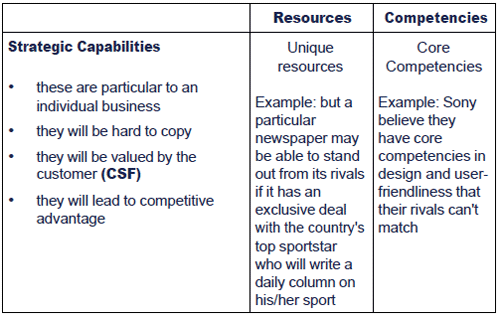
So as part of an internal analysis a business should look for anyunique resources that it may own or core competencies that it hascreated. These would be significant strengths to any business.

 Unique resources and core competencies explained
Unique resources and core competencies explained
- Unique resources are those resources that create competitive advantage and that others cannot imitate or obtain. Examples of unique resources are:
- brand
- situation, for example, near a source of raw material or a source of cheap labour
- sunk costs. Competitors have to cover depreciation costs
- right to use a patented process.
Note that if the unique resource is people-based, the people can move to competitors or start their own business.
- Core competences are the activities, processes and methods through which an organisation uses its resources effectively, in ways that others cannot imitate or obtain. Examples of core competences are:
- sophisticated IT that, for example, enables complex and accurate demand forecasting
- a corporate culture that fosters innovation
- the ability to share and lever knowledge throughout the organisation.


 More on strategic capabilities
More on strategic capabilities
Note that capability refers to resources and competences and their relationship can be shown as:
Strategic capability can also be divided into threshold capabilities and capabilities for competitive advantage.
- Threshold capabilities. These are the minimum capabilities needed for the organisation to be able to compete in a given market. They consist of threshold resources and threshold competences – the resources and competences needed to meet customers' minimum requirements.
- Capabilities for competitive advantage. The capabilities that allow an organisation to beat its competitors. These capabilities must meet the needs and expectations of its customers. Unique capabilities are not enough – they must be valued by the customers.


 Core competences and threshold competences
Core competences and threshold competences
Many theorists of strategic planning argue that strategy should beabout developing and extending competences across markets, rather thanfocusing on one industry and trying to guess what resources andcapabilities will be needed some years hence. Such thoughts have comefrom the study of companies such as Marriott, that one normallyassociates with hotels. However, most of the company's profits come fromactivities that they learned in the hotel business, but have managed totransfer across the organisation – facilities management,hospitality, conference organisation and very many others. The point isthat their experience of competing in hotels has helped them develop arange of competences in which they are world-class – known as corecompetences.
These core competences are complex harmonisations of knowledge,organisational routines and the integration of production, design andmarketing skills. This is a wider use of the term than simply thecompetences one needs to be effective in a particular market. The term'threshold competence' is reserved for these skills that the firm musthave to put a saleable product in front of a customer.
Hamel and Prahalad have argued that thinking of businesses as aportfolio of products and markets, rather than a bundle of competences,is a critical mistake. In their view, strategic management is aboutidentifying, developing and harmonising the core competences across theorganisation. They use the term 'strategic architecture' to discuss theway that information and skills are moved around the organisation. Sonyand Honda, in particular, have a routine of moving experts away fromtheir expertise into different projects and technologies. Consequently,they have a large number of expert generalists working on projects, andcan bring technologies together in unexpected ways and find innovativeapplications for even relatively straightforward ideas.
Although firms can use all the market research techniques availableto any firm, they can also rely rather more on the strategicarchitecture to bring them into contact with customers and partners.Resource-based firms can then diversify on the basis of superiorcompetences and may shatter the existing patterns of competitivebehaviour. For example, Canon entered the photocopier business againstXerox, a company many times its size. However, it had had superiorskills in optics from its experience in cameras and had developedtechnologies that did not infringe Xerox's patents. Marriott moved intomany of its new areas by simply noting what went on in its hotels, andthinking about the value added of the various activities.


 Illustration 2 – Capabilities, resources and competences
Illustration 2 – Capabilities, resources and competences
ÂÂÂThe Coca-Cola Corporation has, for many years, maintained avery strong position in the soft drinks market. Consider its flagshipproduct, Coca-Cola. This has largely survived competition fromsupermarkets' own-label colas. There is no great secret in how to make areasonable imitation (though purists would maintain the imitations arenot as good) and the resources needed are not demanding. The own-labelcolas sell at much lower prices, so high-volume production resources,capable of producing flavoured carbonated water do not seem to beimportant in keeping production prices down. So how has Coca-Colamanaged to keep its dominant position?
It has been argued above that physical resources do not seem to beimportant. Therefore, the answer must lie in non-physical resources(such as a very powerful brand) and core competences. The corecompetences lie in managing the brand by producing memorable globaladvertising, global recognition, careful sponsorship, responding tocustomer requirements (diet/light products).


 Test your understanding 3
Test your understanding 3
Panasonic and Leica formed a joint venture to produce cameras under the trade name 'Lumix'.
How did this enable the companies to gain both threshold and capabilities for competitive advantage?


 Organisational knowledge as a strategic capability
Organisational knowledge as a strategic capability
Knowledge is a strategic capability. An organisation's knowledge ofits environment (such as expected technological changes, changes insubstitute availability etc.) can make it stand out from rivals. It canbe more proactive towards its environment and also be in a position toreact quicker to environmental changes when necessary.
Johnson, Scholes and Whittington define organisational knowledge as:
'the collective experience accumulated through systems, routines and activities of sharing across the organisation.'
Resources (such as staff skills, assets etc.) can be purchased butcapabilities must be developed and grown. Organisations therefore needto work on this. It is not automatic and problems that are discoveredtoo late can be difficult to rectify.
Organisational knowledge is cumulative in nature. It will be builtup over time from past experience and actions. But it does not simplyfollow a learning curve effect (otherwise organisations of a similar'mass' or history would have similar organisational knowledge – whichis not often the case). Organisational knowledge can also be added toand improved. Environmental analysis, staff development, processimprovement, organisational structure etc. (many of these areas arecovered later in the syllabus) can all impact on and improveorganisational knowledge.
Organisations must recognise that successful development oforganisational knowledge can be a critical success factor. A key part ofthis can be knowledge management (which is explored in more detail inchapter 5). Organisational learning is also considered later in the text(in chapter 15).

4 The resource audit
Resources are a vital element of strategic capabilities. An organisation's resource strengths and weaknesses can be evaluated using a resource audit. This summarises resources into categories (using words beginning with 'M'), such as:
- money
- management
- manpower
- manufacturing
- markets
- materials
- make-up

 Further explanation of the 'M's' model
Further explanation of the 'M's' model


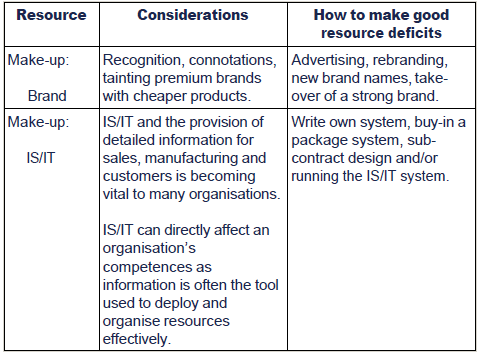

5 The life cycle model
One of the parts of the resource audit is "markets". This analysiscan be performed in greater detail using the product life cycle.
The product life cycle analysis is a technique used to plot theprogress of a product through its life span. The model can be used toassess an individual firm's products (e.g. the iPod Classic), a type ofproduct (e.g. CRT televisions) or an industry (e.g. movies).
It is important in exam questions that you recognise theappropriate lifecycle stage and discuss the implications within thecontext of the scenario.
The model can show between four and six stages. Here, we show four stages:
Typical characteristics of these stages are set out in the following table:

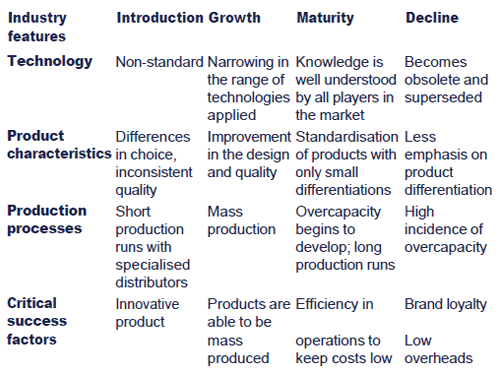

 Illustration 3 – The life cycle model
Illustration 3 – The life cycle model
PCs
Initially, there were relatively few significant producers. Theproduct was innovative, non-standardised, of inconsistent quality andexpensive.
Once it looked as though it would be a successful product manyproducers were attracted into the market. Mass production loweredprices. The range of technologies used narrowed. Intense competitiondeveloped as firms fought for dominance and market share.
Maturity means that the product has become a commodity. Theindustry will be left with just a few large players (Dell, HewlettPackard, etc.). Efficiency is very important to maintain margins. Newentrants will be rare as there is little point in entering an oldmarket.
Decline. Some companies will find that their exit costs arehigh and will be willing to manufacture so long as marginal revenueexceeds marginal costs. Price wars are likely.


 Test your understanding 4
Test your understanding 4
Consider where the following items might be in the product lifecycle and comment on the competitive forces they might experience:
(a)mobile phone services
(b)flat screen (LCD/plasma) televisions.


 Strategy implications of life cycle analysis
Strategy implications of life cycle analysis
Life-cycle curves can be useful devices for explaining therelationships among sales and profit attributes of separate products,collections of products in a business, and collections of businesses in aconglomerate or holding company. Life-cycle analysis has been suggestedby some of its advocates as a basis for selecting appropriate strategycharacteristics at all levels. It also may be viewed as a guide forbusiness level strategy implementation since it helps in selection offunctional level strategies.
Introduction stage strategy implications: during the early stagesof the life cycle, marketing strategy should focus on correcting productproblems in design, features, and positioning so as to establish acompetitive advantage and develop product awareness through advertising,promotion, and personal sales techniques. At the same time, personnelstrategy should focus on planning and recruiting for new product humanresource needs and dealing with union requirements. Also, one wouldexpect the nature of research and development (R&D) strategy toshift from a technical research orientation during the phase prior tointroduction to more of a development orientation during actualintroduction.
Financial strategy would primarily address sources of funds neededto fuel R&D and marketing efforts as well as the capitalrequirements of later production facilities. Capital budgeting decisionswould be outlined during these early stages so that capacity would beadequate to serve growth needs when sales volumes begin to accelerate.
Growth stage strategy implications: during the growth stage,strategic emphases change. Marketing strategy is concerned with quicklycarving out a niche for the product or firm and for its distributioncapabilities, even when doing so may involve risking overcapacity. Toooften, firms have inadvisably accepted quality shortfalls as a necessarycost of rapid growth. Widening profit margins during the growth phasemay even permit certain functional inefficiencies and risk taking.Communication strategy is directed toward establishing brand preferencethrough heavy media use, sampling programmes, and promotion programmes,and strategy should emphasise resource acquisition to maintain strengthand development of ways to continue growth when it begins to slow.
Personnel strategy may focus on developing loyalty, commitment, andexpertise. Training and development programmes and variouscommunication systems are established to build management and employeeteams that can deal successfully with the demands of impending tightcompetition among firms during the maturity phase.
Maturity stage strategy implications: efficiency and profitgenerating ability become major concerns as products enter the maturitystage. Competition grows as more firms enter the market and theimplication is that only the most productive firms with establishedniches and competent people will survive. Marketing efforts concentrateon maintaining customer loyalty.
Production strategy concentrates on efficiency and, at the sametime, sharpens the ability to meet delivery schedules and minimisedefective products. Cost control systems are often put in place.
Personnel strategy may focus on various incentive systems toincrease manufacturing efficiency. Advancements and transfers are usedand some firms try to fit management positions to managers who havepersonalities more attuned to the belt-tightening needs associated withthe maturity stage.
Decline stage strategy implications: when a product reaches thepoint where its markets are saturated an effort is often made to modifyit so that its life cycle is either started anew or its maturity stageextended. When falling sales of a product cannot be reversed and itenters the decline stage, management's emphasis may switch to milking itdry of all profit. Advertising and promotion expenditures are reducedto a minimum. People are transferred to new positions where theirexperience can be brought to bear on products in earlier growth stages(if management were skilful enough to have created such products).
Various strategies have been suggested for products that have entered the decline stage. Hofer and Schendel suggest four choices when sales are less than 5% of those of the industry leaders:
- concentration on a small market segment and reduction of the firm's asset base to the minimum levels needed for survival
- acquisition of several similar firms so as to raise sales to 15% of the leaders' sales
- selling out to a buyer with sufficient cash resources and the willingness to use them to effect a turnaround liquidation
- liquidation.

Cost changes during the life cycle
As a product moves through its life cycle it is likely to find thatthe nature, value and importance of each of it costs will change. Everyproduct will be different, but a typical pattern might be:

 Further discussion on cost changes
Further discussion on cost changes
Every product will be different and there is no hard and fast ruleas to what will happen to product costs. So the above table is simply anillustration of what would 'typically' happen to a product's costs overits life cycle.
If we look at 'competition costs' as an example. Competition costsrepresent element such as the cost of matching competitor prices oroffers, the cost of matching their services, or the cost of competingfor resources such as staff and materials that become scarce whencompetitors enter the market.
In the early stages of product development and introduction thesecosts should be non-existent (if competition do not yet exist) or low(as competitors enter the market). In the growth phase they will startto rise though not yet to high levels as there should be less need tocompete for existing customers as there should be plenty of newcustomers to attract in order to meet goals. But when the market maturesthen these costs can be high as customers become more discerning, it isdifficult to find replacement customers for any that are lost, andrivals look for new ways to gain a competitive advantage.
In the decline phase these costs might actually ease off. Thebusiness might take a deliberate decision to 'harvest' the product andcompete less aggressively, or competitors might themselves realise thatfurther costs here creates a 'lose-lose' situation, or price stabilityarises, or competitors leave the market – there are manyjustifications for a fall in competition costs at this stage.

6 Quantitative analysis
 It is very likely in the exam that the examiner will provide tables anddata in order to provide some of the information that is needed inorder to properly perform the strategic analysis (both external andinternal). It will be vital that students can both interpret and usethis information in their answers.
It is very likely in the exam that the examiner will provide tables anddata in order to provide some of the information that is needed inorder to properly perform the strategic analysis (both external andinternal). It will be vital that students can both interpret and usethis information in their answers.
This information might be provided using various methods and some of the key methods will be:
Tables of data
In order to reduce the amount of text in a scenario the examinerwill often provide tables of data to provide part of the story. It willbe important that a student can understand what the table is trying toexplain, and that this part of the story is used in the answer to thispart of the examination.

 Test your understanding 5
Test your understanding 5
The following data is given for sales of cinema tickets in a large country over the last two years.
Explain what the table tells us and how it might be used in a Five Forces analysis of the industry's competitive environment.

Financial statements
The examiner might provide sets of financial statements and astudent must use this to pull out the key messages and issues. Therewill be some important technique points to this:
- choose three or four key ratios
- there is no need to illustrate the formula or the calculation
- only one comparator should be needed
- focus on the cause of any changes and what this might tell us about the organisation's position

 Explanation of the financial statement analysis technique
Explanation of the financial statement analysis technique
- choose three or four key ratios
The aim is to try to pick some ratios that best tell theorganisations "story". Key ratios might be its sales growth (which canbe linked to the PESTEL), its margins (which can be linked to the 5forces model), and its gearing (which will give an idea of theorganisations risk profile and its ability to raise finance for futureopportunities).
Ratio analysis has already been examined at the fundamentals leveland we are not trying to show how well we can calculate ten or twelvedifferent ratios. A ratio should not be included if it adds nothing tothe story (for example, there is little point in calculating receivabledays if it has not changed during the year and the business does nothave a problem with debt collection).
- there is no need to illustrate the formula or the calculation
This has been examined at the fundamentals level and would onlywaste time at this level. There is also no need to explain what theratio means (for example, comments such as "The gross profit percentageshows how much profit the business makes per $ of turnover" are unlikelyto gain any marks).
- only one comparator should be needed
The examiner will often provide four or five years worth offinancial statements. However, in order to get to the key messages forthe company's story we do not need to calculate the ratios for everyyear. Normally we simply need to compare this years results with lastyears, or perhaps the this years results to the first years results.
- focus on the cause of any changes and what this might tell us about the organisation's position
The key to gaining any marks will be to analyse the data that hasbeen calculated (simply performing the calculation and not discussing itwill not achieve all of the marks that are available). So we need toexplain why a ratio has changed (for example, is it due to changes inthe external or internal environment) and what these changes mean forthe business (for example, does it need to react to these changes or canthe position be improved in the future).


 Ratio analysis
Ratio analysis
Ratios
The mechanics of ratio analysis are repeated here for revision purposes.
Profitability ratios

Efficiency ratios
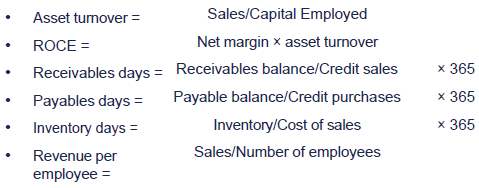
Liquidity ratios

Gearing ratios

Investor ratios



 Inter-firm comparisons
Inter-firm comparisons
Inter-firm comparisons
Inter-firm Comparisons (IFCs) – as previously noted, it ispossible (through use of financial ratios) to compare and contrast theperformance of one entity within an industry with that of another withinthe same industry. It is also possible to compare and contrast theperformance of one firm with that of the whole industry, or a largesample or particular segment of that industry. However, thesecomparisons may suffer from one or more of the following limitations.
- Different accounting methods may be used by individual firms making up the industry sample, or by the firm being compared.
- The industry figures may be biased by one or a few very large firms within the sample.
- Conversely, an industry mean may be misleading for a small or large firm being compared with the mean. Ratios may vary for different sizes of firms.
- The companies within the industry sample may span across more than one industry classification.
- The industry figures may be relevant for a different financial period, and could possibly be out-of-date.

Key Performance Indicators (KPIs)
Other KPIs may also be presented in the scenario (such as customerreturn rates, % of repeat business, market share, age of products etc.).
It will be important to react to this data in the same way that wereact to data that is presented in tables or financial statements –that is, to interpret what they are trying to tell us, and to link thesein to the analysis of the organisation's position.
7 SWOT analysis
Strengths, weaknesses, opportunities and threats
A SWOT analysis can be used as an analysis tool in its own right orcan be used as a summary sheet on which other results can be placed.
- Strengths and weaknesses relate to resources and capabilities: what is the organisation good at? What is it poor at? Where are resources in short supply? Where are resources excellent?
- Opportunities and strengths relate to external factors: what will the effect on the organisation be of economic changes? Can the organisation make use of new technologies? Are new entrants likely to enter the market place? Can a powerful customer dictate terms?
 The examination will feature scenarios detailing the history andcurrent position of an organisation and possible future statesÂ.Candidates will probably have to analyse the organisation's strategicposition, i.e. to carry out a corporate appraisal. It is possible toarrive at a reasonable analysis merely by producing a SWOT analysis, butit is likely to be more productive and impressive to use one or more ofthe other analysis tools, such as PESTEL, to help generate ideas forthe SWOT analysis.
The examination will feature scenarios detailing the history andcurrent position of an organisation and possible future statesÂ.Candidates will probably have to analyse the organisation's strategicposition, i.e. to carry out a corporate appraisal. It is possible toarrive at a reasonable analysis merely by producing a SWOT analysis, butit is likely to be more productive and impressive to use one or more ofthe other analysis tools, such as PESTEL, to help generate ideas forthe SWOT analysis.
Using a SWOT analysis
The first step is to rank in order of importance the findings of the SWOT analysis.
- Strengths that match no opportunity are of little use without an opportunity.
- A distinctive competence is a strength that can be exploited.
Strategies can be developed which:
- neutralise weaknesses or convert them into strengths
- convert threats into opportunities
- match strengths with opportunities.
These are discussed in later chapters.

 Illustration of SWOT analysis
Illustration of SWOT analysis
Illustration – SWOT analysis
We can use the example on the following page to illustrate that theSWOT analysis yields a much clearer view of the extent to which theenvironmental changes and influences provide opportunities or threats,given current strategies and organisational capabilities.
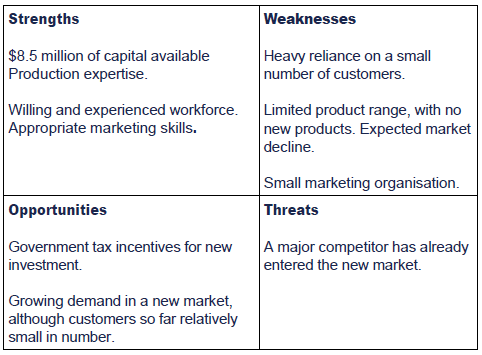
In this example, we might note that the company is having problemsand might be in imminent danger of losing its existing markets and mustdiversify its products, or its products and markets. The new marketopportunity exists to be exploited, and since the number of customers iscurrently small, the relatively small size of the existing marketingforce would not be an immediate barrier. A strategic plan could bedeveloped to buy new equipment and use existing production and marketingto enter the new market, with a view to rapid expansion. Carefulplanning of manpower, equipment, facilities, research and developmentand so on would be required and it would be necessary to meet the threatof competition so as to obtain a substantial share of a growing market.The cost of entry at this early stage of market development should notbe unacceptably high.


 Test your understanding 6
Test your understanding 6
What types of strengths, weaknesses, opportunities and threats would a 'no frills' airline have?

8 Chapter summary
This chapter has covered the following areas:
- defined and described strategic capability, threshold resources, threshold competences, unique resources and core competences
- explained why cost efficiency is important in all organisations
- described the capabilities needed to sustain competitive advantage
- explained, for a range of organisations, the importance of innovation in supporting business strategy
- explained the importance of knowledge management for both profit-seeking and not-for-profit organisations
- described the use of SWOT analysis.
Test your understanding answers

 Test your understanding 1
Test your understanding 1
The two main critical success factors would probably be:
- speedy collection from customers after their request for a parcel to be delivered
- rapid and reliable delivery.


 Test your understanding 2
Test your understanding 2
Their performance can be measured by establishing key performanceindicators for each CSF and measuring actual achievements against them,e.g.:
- Collection from customers within 3 hours of receiving the order, in any part of the country, for orders received before 2.30 pm on a working day.
- Next-day delivery for 100% of parcels to destinations within the UK.
- Delivery within 2 days for 100% of parcels to destinations in Europe.


 Test your understanding 3
Test your understanding 3
Leica was a very famous and prestigious conventional camera maker,esteemed for the quality of its lenses; it had no electronicscapability.
Panasonic has immense electronics design and production capability; it has (or had) no optical capability.
Together the partners gained threshold capability in making high- quality digital cameras – good lenses and good electronics.
It's not clear if the joint venture has generated capabilities forcompetitive advantage. Certainly both partners have strong, respectedbrand names, but other companies (such as Sony and Canon) are verystrong in the digital camera market also. It has yet to be seen if Lumixwill enjoy protection from competitors that will allow long-termcompetitive advantage.


 Test your understanding 4
Test your understanding 4
(a) Mobile phone services
Probably a mature market. The industry wentthrough a very rapid growth stage in many countries; most consumers whowant a mobile now have one. There has been consolidation in theindustry which, because of the infrastructure needed, lends itself tosupporting a few large suppliers. It is relatively unlikely that newentrants will appear as they will have to fight for a share of asaturated market.
Consumers are well informed about call plans and about whatcompetitors offer. Because a telephone number can be retained there arevery low switching costs and consumers are happy to change suppliers.
No sign of decline.
(b) Flat screen (LCD/plasma) televisions
Probably still in the growth stage. Thereis a long way still to go before most conventional TVs are replaced.Prices had been very high initially, but have come down significantly ascompetition intensifies and manufacturing runs become longer. Newentrants would remain a threat as there would still be significantmarket share to win. Prices will continue to fall and manufacturingefficiency will become increasingly important.


 Test your understanding 5
Test your understanding 5
The table shows two things:
- the market overall is not growing
- no one company dominates the market.
As part of a 5 forces analysis the table is likely to indicate thatthis is a competitive market when we analyse competitive forces. Nocompany has significantly better economies of scale in order to achievecost leadership and marketing budgets and techniques are likely to bevery similar which will make differentiation strategies harder. Thecompanies will know that, in order to grow, there is unlikely to be newsales coming into the market and therefore they will have to temptcustomers away from rivals – which will increase the competitiveactivities in the industry.
The table might also provide information on the difficulty that newentrants into the market might have in overcoming the position of thefour established providers.


 Test your understanding 6
Test your understanding 6
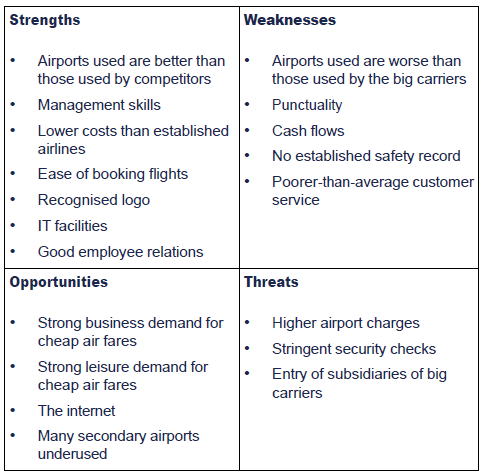

|
Created at 5/24/2012 12:47 PM by System Account
(GMT) Greenwich Mean Time : Dublin, Edinburgh, Lisbon, London
|
Last modified at 5/25/2012 12:55 PM by System Account
(GMT) Greenwich Mean Time : Dublin, Edinburgh, Lisbon, London
|
|
|
|
 |
Rating
:
|
 Ratings & Comments
(Click the stars to rate the page) Ratings & Comments
(Click the stars to rate the page)
|
 |
Tags:
|
|
|
|
|